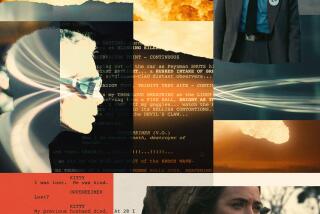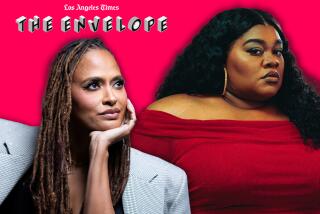Above the cacophony, one courageous voice
- Share via
“Good Night, and Good Luck” couldn’t be more unlikely, more unfashionable -- or more compelling. Everything about it -- its look, its style, even its sound -- stands in stark opposition to the trends of the moment. Yet by sticking to events that are half a century old, it tells a story whose implications for today are inescapable.
An examination of the stand CBS newsman Edward R. Murrow took in 1954 against Sen. Joseph McCarthy, “Good Night” is a marvel of classic restraint in a hopped-up film culture. Shot in elegant black and white with impeccable ensemble acting and moody jazz riffs for a soundtrack, it wouldn’t exist except for the lonely passion of director, co-writer and costar George Clooney.
The son of a TV anchorman, Clooney had the nerve to believe that a drama of ideas could be as entertaining as “Desperate Housewives.” He insisted that a fight for America’s soul, a clash of values over critical intellectual issues like freedom of the press and the excesses of government, had an inherent intensity that would carry everything before it. And it does.
What is especially dramatic about the lean, carefully measured script Clooney co-wrote with actor-producer Grant Heslov (who has a cameo as Murrow colleague Don Hewitt) is its determination to show how agonizingly difficult it is to do the right thing.
While in retrospect it’s easy to believe that standing up against the brutish junior senator from Wisconsin was so much the obvious thing to do that we all would have done it in a heartbeat, “Good Night” takes pains to show how much Murrow risked -- and in fact lost -- by deciding to take that perilous and unpopular step.
To make sure his film was true to the nuances of the situation, Clooney made two key choices: Feeling that no actor could convincingly capture the unsettling combination of bluster, innuendo and meanness that characterized McCarthy, he decided to show the senator only in archival footage. And after briefly flirting with the idea of taking the part of Murrow himself, he gave it to David Strathairn, who made it the role of a lifetime.
Still identified with his fine work in John Sayles films such as “Matewan” and “Eight Men Out,” the actor’s innate air of gravitas and concern helps him appear more like Murrow than Murrow himself. Strathairn’s newscaster is part pillar of rectitude, part bird of prey, a driven man of impeccable taste and tightly wound presence who was never far from the cigarettes that led to an early death.
The best part of Strathairn’s haunted, haunting performance is his voice, the way he is able to uncannily reproduce Murrow’s unmistakable cadences. A big chunk of Murrow’s words in the film are taken directly from his speeches and on-air commentary, and hearing Strathairn read them is close enough to the real thing to be positively spooky.
“Good Night, and Good Luck” is in fact bookended by Murrow’s most famous speech, one he gave to the Radio-Television News Directors Assn. in 1958, four years after he confronted McCarthy, a savage jeremiad about the state of television that is if anything truer today than it was then. The film opens with Murrow talking about the medium’s “built-in allergy to unpleasant or disturbing information” and laments that television “in the main is being used to distract, delude, amuse and insulate us.” He is not a happy man.
The film then cuts back to 1953, to a CBS projection room that consciously echoes a similar scene in “Citizen Kane.” Murrow and his young Turks, including producer Joe Wershba (Robert Downey Jr.), are looking at McCarthy footage and trying to decide if they want to do a piece on the plight of Lt. Milo Radulovich, a Navy pilot about to be kicked out of the military because of suspicious charges of disloyalty that he has not even been able to see, much less respond to.
CBS’ very corporate No. 2 Sig Mickelson (a letter-perfect Jeff Daniels) thinks this is not such a good idea, but Murrow is unrepentant and he and his producer, Fred Friendly (Clooney himself), run with the piece. “I’ve searched my conscience,” Murrow says like a man who means it, “and I can’t for the life of me find any justification for this.”
When, as expected, McCarthy responds by accusing Murrow of having been on the Soviet payroll, the newscaster and his network begin the slow, agonizing process of deciding to take on the senator in a more pointed way. Murrow’s boss, William Paley (Frank Langella), would rather he stick to fluffy interviews on his “Person to Person” program (a particularly arch one with Liberace is included), but finally the air of rectitude Murrow always projected was too much for his employer to resist.
Still, everyone at CBS, especially Murrow’s cohorts, is panicked at the potential consequences of confronting someone powerful and seemingly unassailable, which is one reason Murrow perseveres.
“We’re going to go with the story because the terror is right here in this room,” he tells his team, a terror we feel as much as they do.
Strong as he was in private, Murrow was even more articulate in public, and to hear Strathairn read impeccably written lines like “We must not confuse dissent with disloyalty” and “We cannot defend freedom abroad by deserting it at home” is to note with sadness how far from that kind of eloquence the broadcast media has come today.
As a director intent on showing how Murrow’s choice played out, Clooney has himself made all the right choices, starting with the decision he made to narrow the focus to the issues at hand. Except for a brief scene of Wershba’s home life -- because of company policy his marriage to colleague Shirley Wershba (Patricia Clarkson) was a secret -- we seldom see these characters outside the windowless environment of the TV studio.
The controlled, claustrophobic chaos of that hermetic world is so smartly re-created by production designer Jim Bissell and his team and faultlessly shot by veteran cinematographer Robert Elswit that its lack of breathable air seems to emphasize the seriousness of the situation. Only the potent jazz phrasings of a nameless singer in an adjacent studio, played by triple Grammy winner Dianne Reeves, provides any kind of emotional release.
“Good Night, and Good Luck” returns at its close to Murrow’s own words, specifically to that celebrated 1958 speech it opened with. Very much the angry god taking on broadcasting’s sinners, Murrow resorts to withering scorn against those who say people wouldn’t be interested in intelligent, involved television.
“Because if they are right,” he concludes, “and this instrument is good for nothing but to entertain, amuse and insulate, then the tube is flickering now and we will soon see that the whole struggle is lost. Otherwise, it is merely wires and lights in a box .... Good night. And good luck.”
That last phrase, Murrow’s trademark signoff, gives Clooney’s film an unexpectedly melancholy tinge. For what is unavoidable about “Good Night, and Good Luck” is its reminder that the battles the newscaster struggled with are never permanently won but must be re-fought by every generation. Without someone as fearless, eloquent and impassioned as Murrow to fight them, we’ll need all the luck we can get the next time around.
*
‘Good Night,
and Good Luck’
MPAA rating: PG, for mild thematic elements and brief language.
Times guidelines:
Adult subject matter.
Released by Warner Independent Pictures. Director George Clooney. Producer Grant Heslov. Executive producers Steven Soderbergh, Ben Cosgrove, Jennifer Fox, Todd Wagner, Mark Cuban, Marc Butan, Jeff Skoll. Screenplay George Clooney & Grant Heslov. Cinematographer Robert Elswit. Editor Stephen Mirrione. Costumes Louise Frogley. Production design Jim Bissell. Art director Christa Munro. Set decorator Jan Pascale. Running time: 1 hour, 30 minutes.
In limited release.
More to Read
Only good movies
Get the Indie Focus newsletter, Mark Olsen's weekly guide to the world of cinema.
You may occasionally receive promotional content from the Los Angeles Times.










